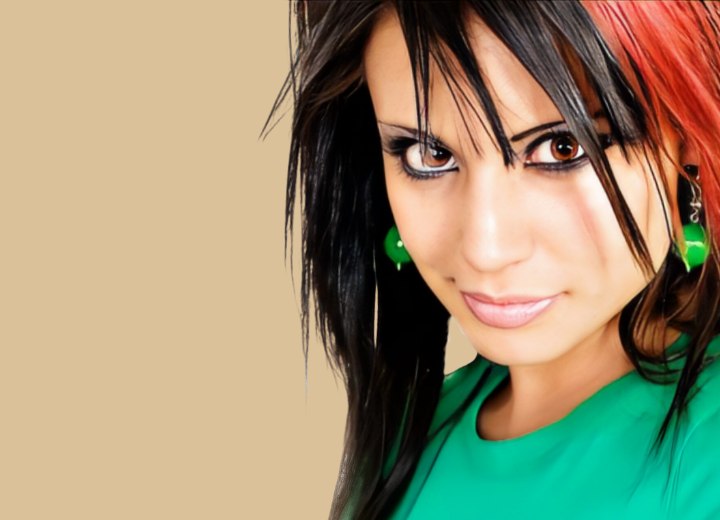Scene Hair

I was asked to give some tips on creating the "Scene" hairstyle, or more specifically, to do a demonstration and diagram to allow someone to recreate the "scene" style. "Scene" isn't really a specific style but rather a "look." The difference is that a look can have many different styles, depending on the individual, and the styles in a "look" aren't necessarily that similar.
I've heard the "Scene" look described as "a happier Emo," and this probably comes from the fact that many of the clothing and hairstyles are similar in appearance, except that the "Scene" look includes more color and a more assertive attitude.
This led to the coining of the term "emotional hardcore" or "emocore," which eventually became "Emo." But Emo was used to describe more than the music of particular bands. It became a buzzword to describe the fans of this music and their emulation of the artists in fashion, culture, and the attitudes portrayed in the songs.
"Scene" has evolved in recent years as the Emo movement has become more mainstream and widely popular. The dramatic elements of the Emo look have remained, with some modifications to incorporate a brighter, bolder personality. If the Emo look is hair dyed black with a long choppy-layered cut and an angled, eye-concealing fringe, then "Scene" brings to it the flash of color in streaks and swipes, particularly in the ends.
Of course, there's more variety in any look than can be conveyed in a simple description. The styles that fall into the Scene category are as varied as you can imagine. There are "Scene looks" that are wavy, straight, longer, shorter, and of virtually any color combination. So, to attempt to give instructions on cutting the "Scene" style isn't possible. However, there are very definite elements to the "Scene style," and we can define those. Let's look at those elements now:
Volume:
The Scene look is always a high-volume look. The hair is bulked up and styled to be full and voluminous. Generally, the volume is a result of blow-drying with root-lifting techniques or backcombing at the scalp to help the hair stand up and out.
Wave:
SScene hair is typically styled to be straight, though there are exceptions. The Scene look can be wavy as long as the waves are minimal and don't get too precise. The intention seems to be to create an edgy look and to avoid appearing too groomed. If it looks like it took hours to curl your hair, it's not Scene.
Length:
Of course, there are scene cuts of virtually any length. And the average scene guy's hair is shorter than the average scene girl's hair will be. But as a general rule, the typical woman's "Scene Cut" is a long, layered look with three stages of layering. The top portion of the hair is generally the shortest (but can still be quite long), with the sides gaining in length, and the bottom portion of the hair falling the longest. These stages are often somewhat exaggerated, with extensions being used at times to add length to the bottom layers.
Layering:
The layering of the hair is choppy and sometimes ragged. The top section is cut with vertical elevation using a horizontal cutting angle (standard with long-layered cuts). The sides and back (the crown area to the top of the nape section) are cut with less elevation and a vertical cutting angle. The lower sections (namely the nape area) are held to a low elevation with a perpendicular cutting angle.
After the base layers are established, the hair can be textured using a point-cutting technique, or deep slicing into the layers. Alternatively, a stylist proficient with a razor tool can cut the hair with said razor and incorporate the choppy layers/texture as the hair is cut.
Continue reading ...